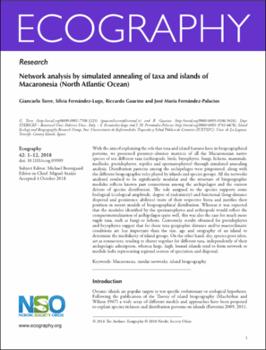Network analysis by simulated annealing of taxa and islands of Macaronesia (North Atlantic Ocean)
Date
2018Abstract
With the aim of explaining the role that taxa and island features have in biogeographical
patterns, we processed presence–absence matrices of all the Macaronesian native
species of ten different taxa (arthropods, birds, bryophytes, fungi, lichens, mammals,
mollusks, pteridophytes, reptiles and spermatophytes) through simulated annealing
analysis. Distribution patterns among the archipelagos were pinpointed, along with
the different biogeographic roles played by islands and species groups. All the networks
analysed resulted to be significantly modular and the structure of biogeographic
modules reflects known past connections among the archipelagos and the current
drivers of species distribution. The role assigned to the species supports some
biological (ecological amplitude, degree of endemicity) and functional (long-distance
dispersal and persistence abilities) traits of their respective biota and justifies their
position in recent models of biogeographical distribution. Whereas it was expected
that the modules identified by the spermatophytes and arthropods would reflect the
compartmentalization of archipelagos quite well, this was also the case for much more
vagile taxa, such as fungi or lichens. Conversely, results obtained for pteridophytes
and bryophytes suggest that for those taxa geographic distance and/or macroclimatic
conditions are less important than the size, age and orography of an island to
determine the modularity of island groups. On the other hand, dry, species-poor islets,
act as connectors, tending to cluster together for different taxa, independently of their
archipelagic adscription, whereas large, high, humid islands tend to form network or
module hubs representing regional centers of speciation and dispersal.






